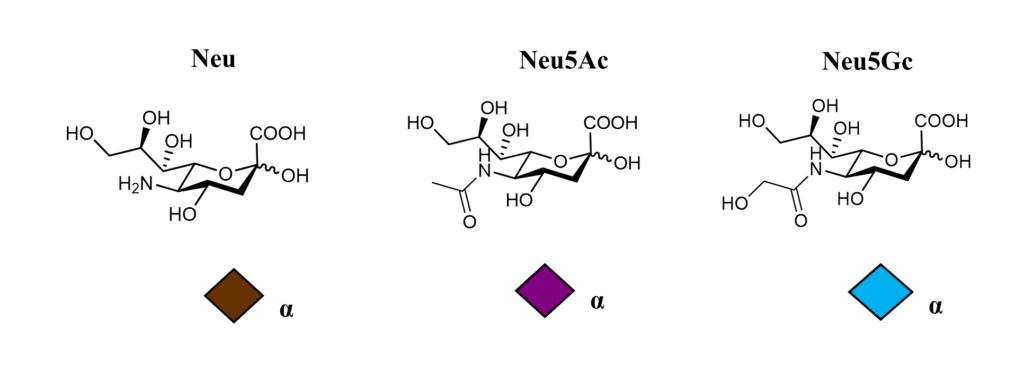Sialic acid-binding immunoglobulin-like lectins (Siglecs) are a family of transmembrane proteins able to recognize sialic acids, nine-carbon atoms sugars highly expressed on the cell surface and one of the major components of the glycocalix. Sialic acids usually occur at the terminal positions of oligosaccharides and glycoconjugates, and they can act as ligands for receptor recognition (trans-interactions) or masking recognition sites on the same cell surface (cis-interactions). Sialic acids occur under differently substituted forms, all derived from the neuraminic acid (Neu) parent molecule, like for example, the N-acetylated variant (Neu5Ac), which is the most abundant, or the N-glycolylated derivative (Neu5Gc), which cannot be synthesized by humans (Figure 1).

https://glycopedia.eu/echapter/article-introduction-3/article-annex/
Free sialic acids are in the energetically preferred β-form, but they adopt the α-anomeric configuration when bound.(Schauer & Kamerling, 2018; A Varki, 2001) Because of their position on the surface of the membranes, sialic acids are mainly available for protein-ligand interactions, mediating several physiological and pathological processes.(Engin et al., 2020; Gianchecchi et al., 2021; Heida et al., 2021; H Läubli et al., 2020; Ajit Varki, 2008; B. Wang, 2012) As mentioned above, Siglecs are one family of proteins that mediate these interactions.
Depending on their expression site, they are involved in many different processes. For this reason, in the last years, Siglecs have emerged as potential therapeutic targets for treating several diseases: the main areas include autoimmunity, infections, inflammation, ageing, and cancer.
The main goal of this chapter is to review all the most recent discoveries about Siglecs. In every section, the main characteristics of each Siglec will be summarized, from their biological and pathological role to the structural information available. Besides, the main essential strategies exploited to target them will also be explained, from the traditional approach with small molecules to the development of multivalent compounds and antibodies.